Kawasaki FT730V – EFI User Manual
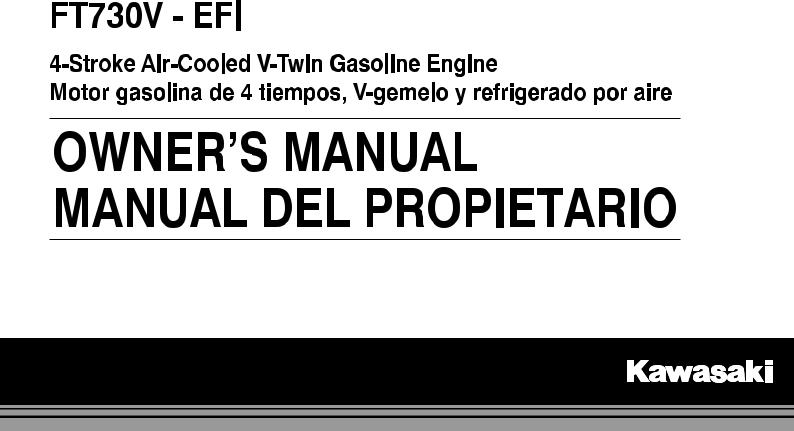

 ENGLISH
ENGLISH
General-purpose Engine
Owner's Manual
Original instructions
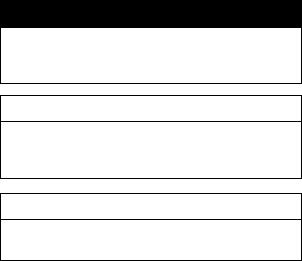
SAFETY AWARENESS
Whenever you see the symbols shown below, heed their instructions! Always follow safe operating and maintenance practices.
 DANGER
DANGER
DANGER indicates a hazardous situation which, if not avoided, will result in death or serious injury.
 WARNING
WARNING
WARNING indicates a hazardous situation which, if not avoided, could result in death or serious injury.
NOTICE
NOTICE is used to address practices not related to personal injury.
NOTE
○NOTE indicates information that may help or guide you in the operation or service of the vehicle.

READ THIS FIRST
For your safety, read this Owner's Manual and understand it thoroughly before operating this ENGINE.
 DANGER
DANGER
Exhaust gas contains carbon monoxide, a colorless, odorless poisonous gas. Inhaling carbon monoxide can cause serious brain injury or death. DO NOT run the engine in enclosed areas. Operate only in a well-ventilated area. Gasoline is extremely flammable and can be explosive under certain conditions, creating the potential for serious burns. When refueling, servicing fuel system, draining gasoline and/or adjusting the carburetor: Stop engine and allow it to cool before refueling. DO NOT smoke. Make sure the area is well-ventilated and free from any source of flame or sparks, including the pilot light of any appliance. DO NOT fill the tank so the fuel level rises into the filler neck or level surface of level gauge. If the tank is overfilled, heat may cause the fuel to expand and overflow through the vents in the tank cap. Wipe off any spilled gasoline immediately. Engines can become extremely hot during normal operation. To prevent fire hazard: Keep the engine at least 1 m (3.3 ft) away from buildings, obstructions and other flammable objects. DO NOT place flammable objects close to the engine. DO NOT expose combustible materials to the engine exhaust. DO NOT use the engine on any forest covered, brush covered or grass covered unimproved land unless spark arrester is installed on the muffler. To avoid getting an electric shock, DO NOT touch spark plugs, plug caps or spark plug leads during engine running. To avoid a serious burn, DO NOT touch a hot engine or muffler. The engine becomes hot during operation. Before you service or remove parts, stop engine and allow the engine to cool. DO NOT place hands or feet near moving or rotating parts. Place a protective cover over pulley, V belt or coupling. DO NOT run engine at excessive speeds. This may result in injury. Always remove the spark plug caps from spark plugs when servicing the engine to prevent accidental starting.
Read warning labels which are on the engine and understand them. If any label is missing, damaged, or worn, get a replacement from an authorized Kawasaki engine dealer and install it in the correct position.
EMISSION CONTROL INFORMATION
Fuel Information
THIS ENGINE IS CERTIFIED TO OPERATE ON UNLEADED REGULAR GRADE GASOLINE ONLY. A minimum of 87 octane of the antiknock index is recommended. The antiknock index is posted on service station pumps in the U.S.A.
Emission Control Information
To protect the environment in which we all live, Kawasaki has incorporated an exhaust emission control system in compliance with applicable regulations of the United States Environmental Protection Agency (EPA). Also, depending on when your engine was produced, it may have an assigned emissions durability period.
* See below for the engine emissions durability period that may apply to your engine.
Exhaust Emission Control System
The exhaust emission control system applied to this engine consists of a fuel system and an Electronic Fuel Injection (EFI) system having optimum ignition timing characteristics. The EFI system has been calibrated to provide lean air/fuel mixture characteristics and optimum fuel economy with a suitable air cleaner and exhaust system.
A sealed-type crankcase emission control system is also used to eliminate blow-by gasses. The blow-by gasses are led to a breather chamber through the crankcase and from there to the air cleaner.
Engine Emissions Compliance Period
Engines Greater Than or Equal To 225 cc
Durability Period – 1,000 hours (Category A)
If your engine has an assigned emissions durability period it will be located on the certification label attached to the engine (IMPORTANT ENGINE INFORMATION).
High Altitude Performance Adjustment Information
Engine models with fuel injection do not require high altitude performance adjustment.
Maintenance and Warranty
Proper maintenance is necessary to ensure that your engine will continue to have low emission levels. This Owner's Manual contains those maintenance recommendations for your engine. Those items identified by the Periodic Maintenance Chart are necessary to ensure compliance with the applicable standards.
As the owner of the engine, you have the responsibility to make sure that the recommended maintenance is carried out according to the instructions in this Owner's Manual at your own expense.
The Kawasaki Limited Emission Control System Warranty requires that you return your engine to an authorized Kawasaki engine dealer for remedy under warranty. Please read the warranty carefully, and keep it valid by complying with the owner's obligations it contains.
Tampering with Emission Control System Prohibited
Federal law prohibit the following acts or the causing there of: (1) the removal or rendering inoperative by any person other than for purposes of maintenance, repair, or replacement, of any device or element of design incorporated into any new engine for the purposes of emission control prior to its sale or delivery to the ultimate purchaser or while it is in use, or (2) the use of the engine after such device or element of design has been removed or rendered inoperative by any person.
Among those acts presumed to constitute tampering, do not tamper with the original emission related parts below:
•Fuel injection system, and their internal parts
•Spark Plug
•Electronic ignition system
•Fuel filter element
•Air cleaner element
•Crankcase
•Cylinder heads
•Breather chamber and internal parts
•Intake pipe and tube
FOREWORD
We wish to thank you for purchasing this Kawasaki engine.
Please read this Owner's Manual carefully before starting your new engine so that you will be thoroughly familiar with the proper operation of your engine's control, its features, capabilities and limitations.
Also read the manual of the equipment to which this engine is attached.
To ensure a long, trouble-free life for your engine, give it the proper care and maintenance described in this manual. Always keep this manual at your fingertip so that you can refer to it whenever you need information. This manual should be considered a permanent part of the engine and should remain with the engine when it is sold.
Please note that the photographs and illustrations shown in this manual are based on Model FT730V EFI as a typical example among other similar models.
All rights reserved. No part of this publication may be reproduced without our prior written permission.
This publication includes the latest information available at the time of printing. However, there may be minor differences between the actual product and illustrations and text in this manual.
All products are subject to change without prior notice or obligation.
KAWASAKI HEAVY INDUSTRIES, LTD.
Motorcycle & Engine Company
© 2017 Kawasaki Heavy Industries, Ltd. |
Sep. 22, 2017 (1) (I) |
TABLE OF CONTENTS
GENERAL INFORMATION ................................ |
9 |
Location of Safety Related Labels ................... |
9 |
Location of Parts .............................................. |
10 |
Engine Serial Number ...................................... |
11 |
Tune-up Specifications ..................................... |
11 |
Battery Capacity ............................................... |
12 |
Fuel ................................................................... |
12 |
STARTING .......................................................... |
14 |
Start Engine ...................................................... |
14 |
OPERATING ....................................................... |
16 |
Warming Up ...................................................... |
16 |
Engine Inclination ............................................. |
16 |
MIL (Malfunction Indicator Light) ...................... |
17 |
Reduced Power Mode (Engine speed reduced |
|
to low idle) ..................................................... |
17 |
STOPPING .......................................................... |
18 |
Stopping the Engine ......................................... |
18 |
Ordinary Stop ................................................ |
18 |
Emergency Stop ............................................ |
18 |
ADJUSTMENT .................................................... |
19 |
Engine Speed Adjustment ................................ |
19 |
MAINTENANCE .................................................. |
20 |
Periodic Maintenance Chart ............................ |
21 |
Oil Level Check ................................................ |
23 |
Oil Change ....................................................... |
24 |
Oil Filter Change .............................................. |
26 |
Air Cleaner Service .......................................... |
26 |
Air Cleaner ..................................................... |
26 |
Foam Element ............................................... |
26 |
Paper Element ............................................... |
27 |
Cap (Dust Ejector Valve) ............................... |
27 |
Replace the air cleaner element ................... |
27 |
Fuel Filter and Fuel Pump Service ................... |
29 |
Spark Plug Service ........................................... |
29 |
Fuse Service .................................................... |
30 |
Cooling System Cleaning ................................. |
31 |
STORAGE ........................................................... |
35 |
Engine Storage Procedure ............................... |
35 |
TROUBLESHOOTING GUIDE ........................... |
36 |
ENVIRONMENTAL PROTECTION .................... |
39 |
SPECIFICATIONS .............................................. |
40 |
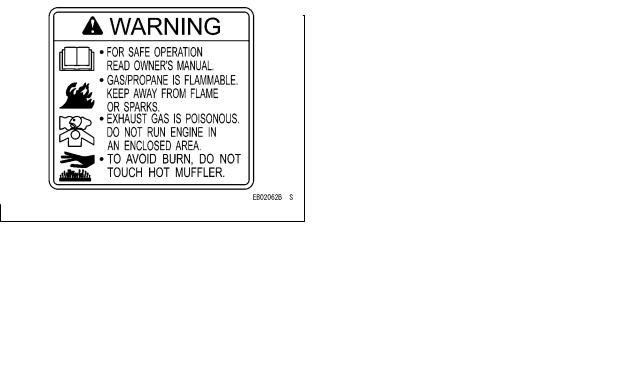
GENERAL INFORMATION 9
GENERAL INFORMATION
Location of Safety Related Labels |
A) |
|
B)
A.Engine Maintenance
B.Warning Label
C.Product Label (Engine Serial Number)
D.Emission Label
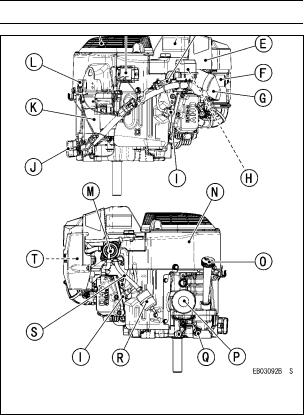
10 GENERAL INFORMATION
Location of Parts
A.Guard/Air Intake Screen
B.Voltage Regulator
C.Air Cleaner
D.Diagnostic Connector E. Air Cleaner Cover
F. Throttle Body/ECU
G.Cap (Dust Ejector Valve)
H.2 A/10 A Fuse
I.Spark Plug Cap/Spark Plug
J.Engine Main Harness Connector
K.Starter Motor
L.40 A Fuse
M.Fuel Pump (Pulse)
N.Fan Housing
O.Oil Gauge/Oil Filler P. Oil Filter
Q.Oil Drain Plug
R.Fuel Filter S. Fuel Tube
T. Fuel Pump (Electric)
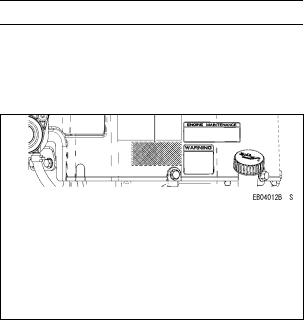
Engine Serial Number
The engine serial number is your only means of identifying your particular engine from others of the same model type.
This engine serial number is needed by an authorized Kawasaki engine dealer when ordering parts.
A. Engine Serial Number
|
GENERAL INFORMATION 11 |
|
|
|
|
Tune-up Specifications |
||
|
|
|
ITEM |
|
Specifications |
|
|
|
Ignition Timing |
|
Unadjustable |
|
|
|
Spark Plugs: |
|
NGK BPR4ES |
Gap |
|
0.75 mm (0.030 in.) |
|
|
|
Low Idle Speed |
|
1 550 r/min (rpm) |
|
|
|
High Idle Speed |
|
3 600 r/min (rpm) |
|
|
IN 0.10 ~ 0.15 mm |
Valve Clearance |
|
(0.004 ~ 0.006 in.) |
|
EX 0.10 ~ 0.15 mm |
|
|
|
|
|
|
(0.004 ~ 0.006 in.) |
|
|
|
Other Specifications |
|
No other adjustment |
|
needed |
|
|
|
|
|
|
|
|
NOTE |
|
○High and low idle speeds may vary depending on the equipment on which the engine is used. Refer to the equipment specification.

12 GENERAL INFORMATION
Battery Capacity
 WARNING
WARNING
Prevent sparks and/or electrical system damage by removing the negative (–) cable from the battery before attempting any repair or maintenance.
Battery Capacity Recommended
Minimum Recommended Battery Capacity
12 V 550 CCA Class
Fuel
Use only clean, fresh, unleaded regular grade gasoline.
NOTICE
Do not mix oil with gasoline.
Octane Rating
The octane rating of a gasoline is a measure of its resistance to “knocking”. Using a minimum of 87 octane by the antiknock index is recommended.
The antiknock index is posted on service station pumps in the U.S.A.
NOTE
○If “knocking or “pinging” occurs, use a different brand of gasoline or higher octane rating.
○When not operating your kawasaki engine more than once per month, you can mix a fuel stabilizer with gasoline in the fuel tank. Fuel stabilizer additive could inhibit oxidation of fuel.
Oxygenated Fuel
Oxygenates (either ethanol or MTBE) are added to the gasoline. If you use the oxygenates, be sure it is unleaded and meets the minimum octane rating requirement.
The followings are the EPA approved percentages of fuel oxygenates.
